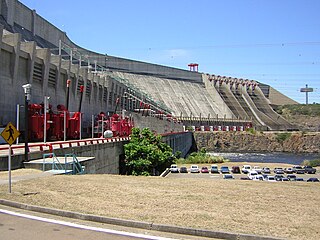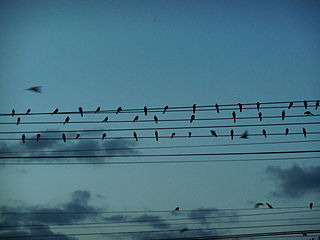Related Research Articles

The economy of Ecuador is the eighth largest in Latin America and the 69th largest in the world by total GDP. Ecuador's economy is based on the export of oil, bananas, shrimp, gold, other primary agricultural products and money transfers from Ecuadorian emigrants employed abroad. In 2017, remittances constituted 2.7% of Ecuador's GDP. The total trade amounted to 42% of the Ecuador's GDP in 2017.

The Kariba Dam is a double curvature concrete arch dam in the Kariba Gorge of the Zambezi river basin between Zambia and Zimbabwe. The dam stands 128 metres (420 ft) tall and 579 metres (1,900 ft) long. The dam forms Lake Kariba, which extends for 280 kilometres (170 mi) and holds 185 cubic kilometres (150,000,000 acre⋅ft) of water.

The Itaipu Dam is a hydroelectric dam on the Paraná River located on the border between Brazil and Paraguay. It is the third largest hydroelectric dam in the world, and holds the 45th largest reservoir in the world.

Hydroelectricity, or hydroelectric power, is electricity generated from hydropower. Hydropower supplies 15% of the world's electricity, almost 4,210 TWh in 2023, which is more than all other renewable sources combined and also more than nuclear power. Hydropower can provide large amounts of low-carbon electricity on demand, making it a key element for creating secure and clean electricity supply systems. A hydroelectric power station that has a dam and reservoir is a flexible source, since the amount of electricity produced can be increased or decreased in seconds or minutes in response to varying electricity demand. Once a hydroelectric complex is constructed, it produces no direct waste, and almost always emits considerably less greenhouse gas than fossil fuel-powered energy plants. However, when constructed in lowland rainforest areas, where part of the forest is inundated, substantial amounts of greenhouse gases may be emitted.

The Simón Bolívar Hydroelectric Plant, also Guri Dam, previously known as the Raúl LeoniHydroelectric Plant, is a concrete gravity and embankment dam in Bolívar State, Venezuela, on the Caroni River, built from 1963 to 1969. It is 7,426 metres long and 162 m high. It impounds the large Guri Reservoir with a surface area of 4,250 square kilometres (1,641 sq mi).

As of 2018, renewable energy accounted for 79% of the domestically produced electricity used in Brazil.

Burning of renewable resources provides approximately 90 percent of the energy in Uganda, though the government is attempting to become energy self-sufficient. While much of the hydroelectric potential of the country is untapped, the government decision to expedite the creation of domestic petroleum capacity coupled with the discovery of large petroleum reserves holds the promise of a significant change in Uganda's status as an energy-importing country.

Nicaragua is the country in Central America with the lowest electricity generation, as well as the lowest percentage of population with access to electricity. The unbundling and privatization process of the 1990s did not achieve the expected objectives, resulting in very little generation capacity added to the system. This, together with its high dependence on oil for electricity generation, led to an energy crisis in 2006 from which the country has not fully recovered yet.

The power sector in the Dominican Republic has traditionally been, and still is, a bottleneck to the country's economic growth. A prolonged electricity crisis and ineffective remedial measures have led to a vicious cycle of regular blackouts, high operating costs of the distribution companies, large losses including electricity theft through illegal connections, high retail tariffs to cover these inefficiencies, low bill collection rates, a significant fiscal burden for the government through direct and indirect subsidies, and very high costs for consumers as many of them have to rely on expensive alternative self-generated electricity. According to the World Bank, the revitalization of the Dominican economy depends greatly on a sound reform of the sector.
Brazil has the largest electricity sector in Latin America. Its capacity at the end of 2021 was 181,532 MW. The installed capacity grew from 11,000 MW in 1970 with an average yearly growth of 5.8% per year. Brazil has the largest capacity for water storage in the world, being dependent on hydroelectricity generation capacity, which meets over 60% of its electricity demand. The national grid runs at 60 Hz and is powered 83% from renewable sources. This dependence on hydropower makes Brazil vulnerable to power supply shortages in drought years, as was demonstrated by the 2001–2002 energy crisis.
Electricity in Pakistan is generated, transmitted and distributed by two vertically integrated public sector companies, first one being Water and Power Development Authority (WAPDA) responsible for the production of hydroelectricity and its supply to the consumers by electricity distribution companies (DISCOS) under the Pakistan Electric Power Company (PEPCO) being the other integrated company. Currently, there are 12 distribution companies and a National Transmission And Dispatch Company (NTDC) which are all in the public sector except Karachi Electric in the city of Karachi and its surrounding areas. There are around 42 independent power producers (IPPs) that contribute significantly in electricity generation in Pakistan.

The electricity sector of Uruguay has traditionally been based on domestic hydropower along with thermal power plants, and reliant on imports from Argentina and Brazil at times of peak demand. Over the last 10 years, investments in renewable energy sources such as wind power and solar power allowed the country to cover in early 2016 94.5% of its electricity needs with renewable energy sources.

The 2009 Ecuador electricity crisis was caused by a severe drought that depleted water levels at hydroelectric plants. Ecuador experienced rolling blackouts for two to six hours per day that lasted from November 2009 until January 2010.
The Paute Dam, also known as the Daniel Palacios Dam and the Amaluza Dam, is a hydroelectric dam in Ecuador. It is located on the Paute River, 125 kilometres (78 mi) from Cuenca. After the privatization of power generation that began in 1996 under the government of Sixto Durán Ballén, the dam passed into the hands of the company Hidropaute SA and then returned to state ownership during the government of Rafael Correa when Hidropaute became part of the Ecuador Electricity Corporation.
The electricity sector in Venezuela is heavily dependent on hydroelectricity, with this energy source accounting for 64% of the country's electricity generation in 2021. The country relies on six hydroelectric plants, with Central Hidroeléctrica Guri providing the majority of this capacity. In 2021, natural gas and petroleum contributed 25% and 11% to electricity generation, respectively. Managed by CORPOELEC, the sector has declined due to outdated infrastructure and insufficient investment, reducing generation from 120 billion kWh in 2013 to 95 billion kWh in 2021. Despite a 99% electrification rate in 2019, frequent power outages have worsened, peaking with a nationwide blackout in 2019 and increasing by 22% from 2021 to 2022. Fuel shortages have also hampered power plant operations.

Primary energy consumption in Spain in 2020 was mainly composed of fossil sources. The largest sources are petroleum (42.3%), natural gas (19.8%) and coal (11.6%). The remaining 26.3% is accounted for by nuclear energy (12%) and different renewable energy sources (14.3%). Domestic production of primary energy includes nuclear (44.8%), solar, wind and geothermal (22.4%), biomass and waste (21.1%), hydropower (7.2%) and fossil (4.5%).
The Mazar Dam is a concrete-face rock-fill dam on the Paute River Cañar Province, Ecuador. The purpose of the dam is hydroelectric power generation and it is located directly upstream of the Paute Dam as part of the Amaluza-Molino project. The dam's power station has an installed capacity of 170 megawatts (230,000 hp). Construction on the dam began in 2004; the generators were commissioned in 2010 and the remaining works were completed in 2011.
Venezuela has experienced a marked deficit in the generation of electrical energy. The immediate cause of the energy crisis was a prolonged drought that caused the water in the reservoir of the Simón Bolívar Hydroelectric Plant to reach very low levels. Although various measures were taken to overcome the crisis, one of the most controversial was the implementation of a program of electrical rationing throughout the country, except in the capital Caracas, which was ultimately officially suspended in June 2010, due to the recovery of reservoirs due to the rains, and not to interrupt the transmission of the 2010 FIFA World Cup. Power cuts have continued to occur in the interior of the country, although with less frequency and duration, this time driven by failures in other parts of the system. The situation of "electrical emergency" decreed by the government on 21 December 2009 was suspended on 30 November 2010; however, on 14 May 2011, after the country experienced two national blackouts, the government of Hugo Chávez announced a temporary rationing plan and acknowledged that the electricity system continued to face "generation weaknesses" that they did not expect to surpass until end the year.
The 2019 Sri Lanka electricity crisis was a crisis which happened nearly a month from 18 March to 10 April 2019 faced by Sri Lanka caused by a severe drought that depleted water levels at hydroelectric plants. Sri Lanka experienced rolling blackouts for three to five hours per day except on Sundays in all parts of the island nation at different time schedules that started from 24 March 2019 to present. This is regarded as one of the worst blackouts confronted in Sri Lanka since 2016 and the longest ever blackout recorded in history of the country. However it was revealed that the main electricity providing institution Ceylon Electricity Board had restricted the power supply to almost all regions of the country without proper prior notice and implemented a time schedule unofficially from 24 March 2019. However the Ministry of Power and Renewable Energy revealed that it didn't grant and approve permission to CEB to impose power cuts.

Andrea Arrobo Peña is an Ecuadorian who became her country's minister of energy in 2023. She had to resign the following year in the light of continuing blackouts.
References
- 1 2 3 4 5 6 7 Brown 2024.
- ↑ US News & World Report 2024.
- ↑ Zalakeviciute, Diaz & Rybarczyk 2024, p. 3, page numbers are from the PDF version.
- ↑ The Rio Times 2024.
- ↑ France 24 2024.
- 1 2 Reuters 2024.
- ↑ Segovia Velasteguí 2024.
- ↑ Zalakeviciute, Diaz & Rybarczyk 2024, p. 10.